Lyons W.C. (ed.). Standard handbook of petroleum and natural gas engineering.2001- Volume 1
Подождите немного. Документ загружается.

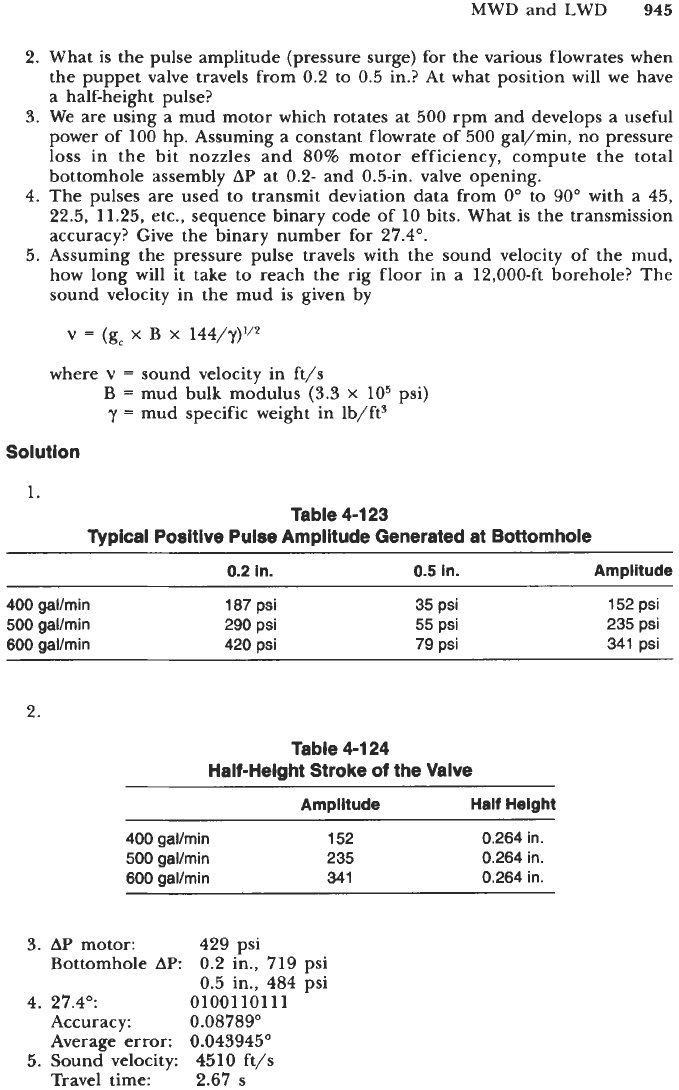
MWD and LWD
945
2. What is the pulse amplitude (pressure surge) for the various flowrates when
the puppet valve travels from 0.2 to 0.5 in.? At what position will we have
a half-height pulse?
3. We are using a mud motor which rotates at
500
rpm and develops a useful
power of
100
hp. Assuming a constant flowrate of 500 gal/min, no pressure
loss in the bit nozzles and 80% motor efficiency, compute the total
bottomhole assembly
AP
at
0.2-
and 0.5-in. valve opening.
4. The pulses are used to transmit deviation data from
0'
to
90'
with a
45,
22.5, 11.25, etc., sequence binary code of
10
bits. What is the transmission
accuracy? Give the binary number for 27.4'.
5.
Assuming the pressure pulse travels with the sound velocity
of
the
mud,
how long will it take to reach the rig floor in a 12,000-ft borehole? The
sound velocity in the mud is given by
v
=
(g,
x
B
x
144/~)'/~
where
v
=
sound velocity in ft/s
B
=
mud
bulk
modulus (3.3
x
lo5
psi)
y
=
mud specific weight in lb/ft3
Solution
1.
Table 4-123
Typical Positive Pulse Amplitude Generated at Bottomhole
0.2
in.
0.5
in.
Amplitude
~~~
400 gal/min 187 psi 35 psi
152
psi
500
gal/min 290 psi
55
psi 235 psi
600
gal/min 420 psi 79 psi 341 psi
2.
Table 4-1 24
Half-Height Stroke
of
the Valve
Amplltude
Half
Height
400
gal/min 152 0.264
in.
0.264 in.
500
gal/min 235
600
gal/min 341 0.264 in.
3.
AP
motor: 429 psi
Bottomhole
AP:
0.2
in., 719 psi
0.5
in., 484 psi
4.
27.4":
0100110111
Accuracy: 0.08789'
Average error: 0.043945'
5.
Sound velocity:
4510
ft/s
Travel time: 2.67
s
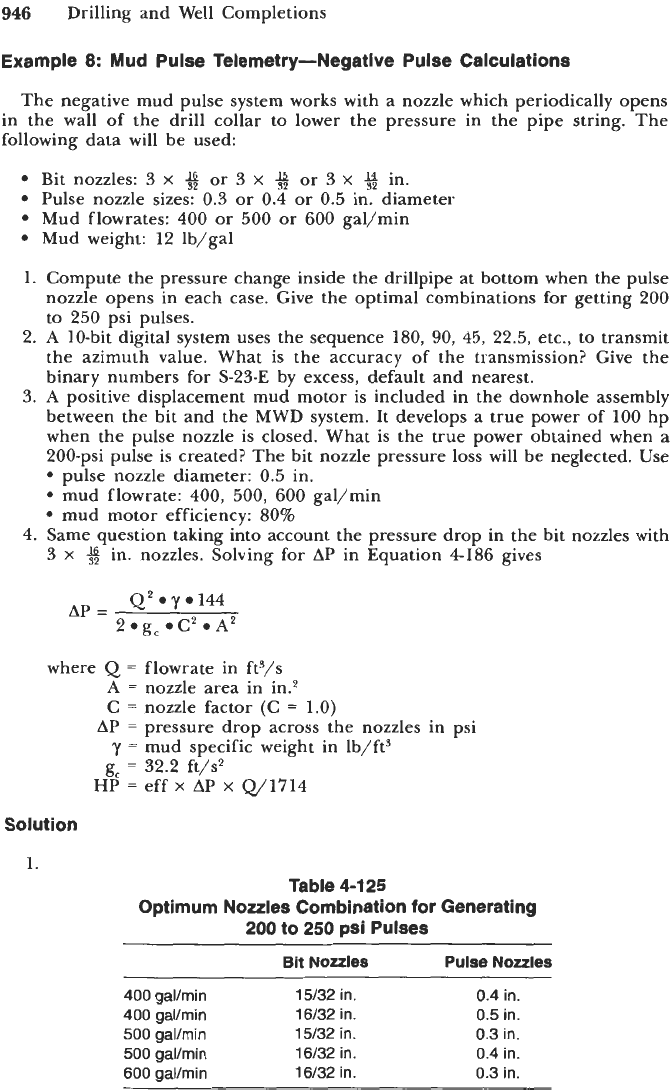
946
Drilling and Well Completions
Example
8:
Mud Pulse Telemetry-Negatlve Pulse Calculations
The negative mud pulse system works with a nozzle which periodically opens
in the wall of the drill collar
to
lower the pressure in the pipe string. The
following data will be used:
Bit nozzles: 3
x
$j
or
3
x
$
or
3
x
4$
in.
Pulse nozzle sizes:
0.3
or
0.4
or
0.5 in. diameter
Mud flowrates:
400
or
500
or
600
gal/min
Mud weight: 12 lb/gal
1.
Compute the pressure change inside the drillpipe at bottom when the pulse
nozzle opens in each case. Give the optimal combinations for getting 200
to 250 psi pulses.
2.
A
10-bit digital system uses the sequence
180,
90,
45,
22.5, etc., to transmit
the azimuth value. What
is
the accuracy
of
the transmission? Give the
binary numbers
for
S-23-E by excess, default and nearest.
3.
A
positive displacement mud motor is included in the downhole assembly
between the bit and the
MWD
system. It develops a true power of
100
hp
when the pulse nozzle is closed. What is the true power obtained when a
200-psi pulse is created? The bit nozzle pressure loss will be neglected. Use
pulse nozzle diameter: 0.5 in.
mud flowrate:
400,
500,
600
gal/min
mud motor efficiency:
80%
3
X
$j
in. nozzles. Solving for AP in Equation
4-186
gives
4.
Same question taking into account the pressure drop in the bit nozzles with
Q'
y
144
2
g,
C2
A2
AP
=
where
Q
=
flowrate in fts/s
A
=
nozzle area in in.2
C
=
nozzle factor
(C
=
1.0)
y
=
mud specific weight in lb/ft3
AP
=
pressure drop across the nozzles in psi
g,
=
32.2 ft/s2
HP
=
eff
x
AP
x
Q/1714
Solution
1.
Table
4-125
Optimum Nozzles Combination for Generating
200
to
250
psi Pulses
~ ~~~
Bit
Nozzles
Pulse
Nozzles
400
gal/min
15/32 in.
400
galimin 16/32 in.
500
gallmin 15/32
in.
500
gallmin 16/32 in.
600 gal/rnin 16/32 in.
0.4
in.
0.5
in.
0.3
in.
0.4
in.
0.3 in.
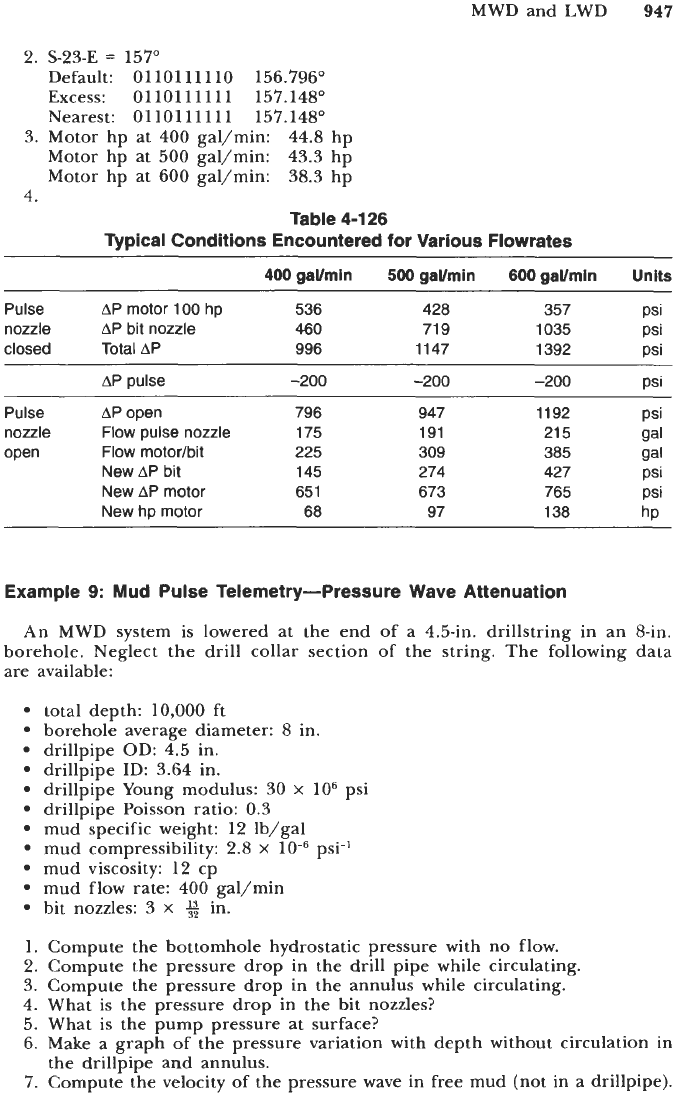
MWD and LWD
947
2. S-23-E
=
157"
Default:
0
1 10 1 1 1
1
10 156.796"
Excess:
01 101 11 11
1
157.148'
Nearest:
0
1 10
1 1
1 1 1
1
157.148"
3.
Motor hp at
400
gal/min:
Motor hp at
500
gal/min:
Motor hp at
600
gal/min:
44.8
hp
43.3
hp
38.3
hp
Table
4-1
26
Typical Conditions Encountered for Various Flowrates
4.
400
gaVmin
500
gaUmin
600
gaUmin
Units
Pulse AP motor
100
hp
536 428 357
psi
nozzle
AP bit nozzle
460 71 9 1035
psi
closed
Total AP
996 1147 1392
psi
AP pulse
-200 -200 -200
psi
~
Pulse AP open
796 947 1192
psi
nozzle Flow pulse nozzle
175 191 21 5
gal
open Flow motodbit
225 309 385
gal
New AP bit
145 274 427
PSI
New hp motor
68 97 138
hP
New AP motor
65
1
673 765
psi
Example
9:
Mud Pulse Telemetry-Pressure Wave Attenuation
An
MWD
system is lowered at the end of
a
4.5-in.
drillstring in an 8-in.
borehole. Neglect the drill collar section of the string. The following data
are available:
total depth:
10,000
ft
borehole average diameter:
8
in.
drillpipe OD:
4.5
in.
drillpipe
ID:
3.64
in.
drillpipe Young modulus:
30
x
lo6
psi
drillpipe Poisson ratio:
0.3
mud specific weight:
12
lb/gal
mud compressibility:
2.8
x
psi-'
mud viscosity:
12
cp
mud flow rate:
400
gal/min
bit nozzles:
3
x
$
in.
1.
Compute the bottomhole hydrostatic pressure with no flow.
2.
Compute the pressure drop in the drill pipe while circulating.
3.
Compute the pressure drop in the annulus while circulating.
4.
What is the pressure drop in the bit nozzles?
5.
What is the pump pressure at surface?
6.
Make
a
graph
of
the pressure variation with depth without circulation in
7.
Compute the velocity of the pressure wave in free mud (not in a drillpipe).
the drillpipe and annulus.
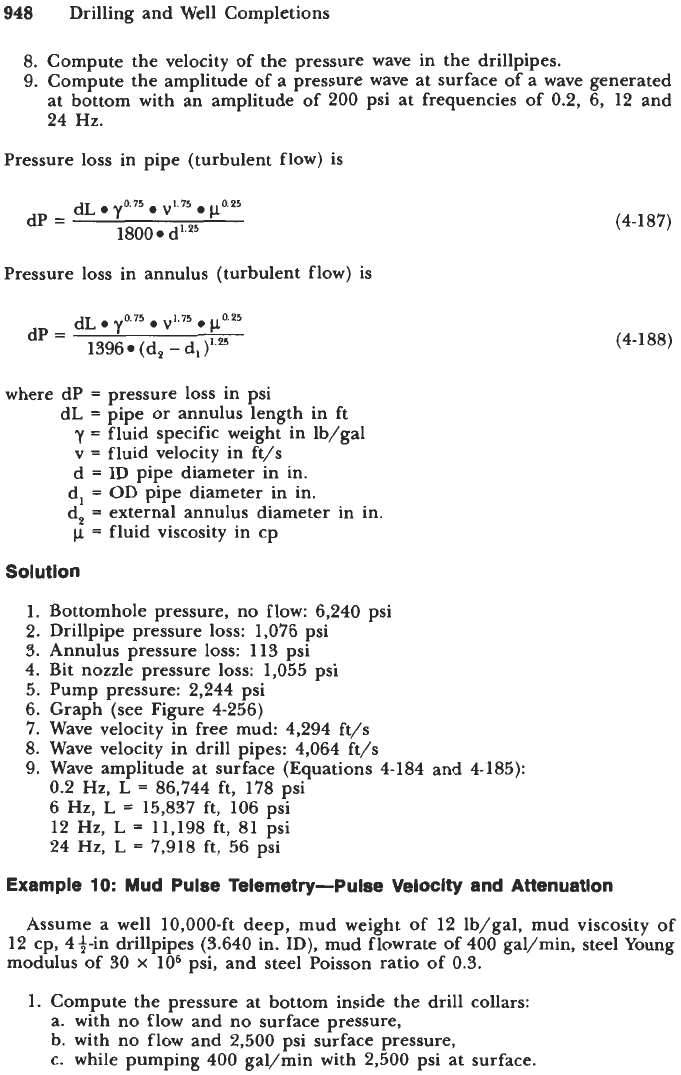
948
Drilling and Well Completions
8.
Compute the velocity of the pressure wave in the drillpipes.
9. Compute the amplitude of a pressure wave at surface of a wave generated
at bottom with an amplitude of 200 psi at frequencies of 0.2, 6, 12 and
24 Hz.
Pressure loss in pipe (turbulent flow) is
Po=
dL
y0.75
dP
=
1800. d’.25
Pressure loss in annulus (turbulent flow) is
Class
dL
y0.75
dP
=
1396 (d,
-
d,
(4-1 87)
(4-188)
where dP
=
pressure loss in psi
dL
=
pipe
or
annulus length in ft
y
=
fluid specific weight in lb/gal
v
=
fluid velocity in ft/s
d
=
ID pipe diameter in in.
d,
=
OD pipe diameter in in.
d,
=
external annulus diameter in in.
p
=
fluid viscosity in cp
Solution
1.
Bottomhole pressure, no flow: 6,240 psi
2. Drillpipe pressure loss: 1,076 psi
3.
Annulus pressure loss: 113 psi
4. Bit nozzle pressure loss: 1,055 psi
5. Pump pressure: 2,244 psi
6. Graph (see Figure 4-256)
7. Wave velocity in free mud: 4,294 ft/s
8.
Wave velocity in drill pipes: 4,064 ft/s
9. Wave amplitude at surface (Equations 4-184 and 4-185):
0.2 Hz,
L
=
86,744 ft, 178 psi
6 Hz,
L
=
15,837 ft, 106 psi
12 Hz,
L
=
11,198 ft, 81 psi
24 Hz,
L
=
7,918 ft, 56 psi
Example
10:
Mud Pulse Telemetry-Pulse
Veloclty
and Attenuation
Assume a well 10,000-ft deep, mud weight of 12 lb/gal, mud viscosity of
12 cp, 4+in drillpipes (3.640 in. ID), mud flowrate of 400 gal/min, steel Young
modulus of 30
x
lo6
psi, and steel Poisson ratio of 0.3.
1.
Compute the pressure at bottom inside the drill collars:
a. with no flow and no surface pressure,
b. with no flow and 2,500 psi surface pressure,
c. while pumping
400
gal/min with 2,500 psi at surface.
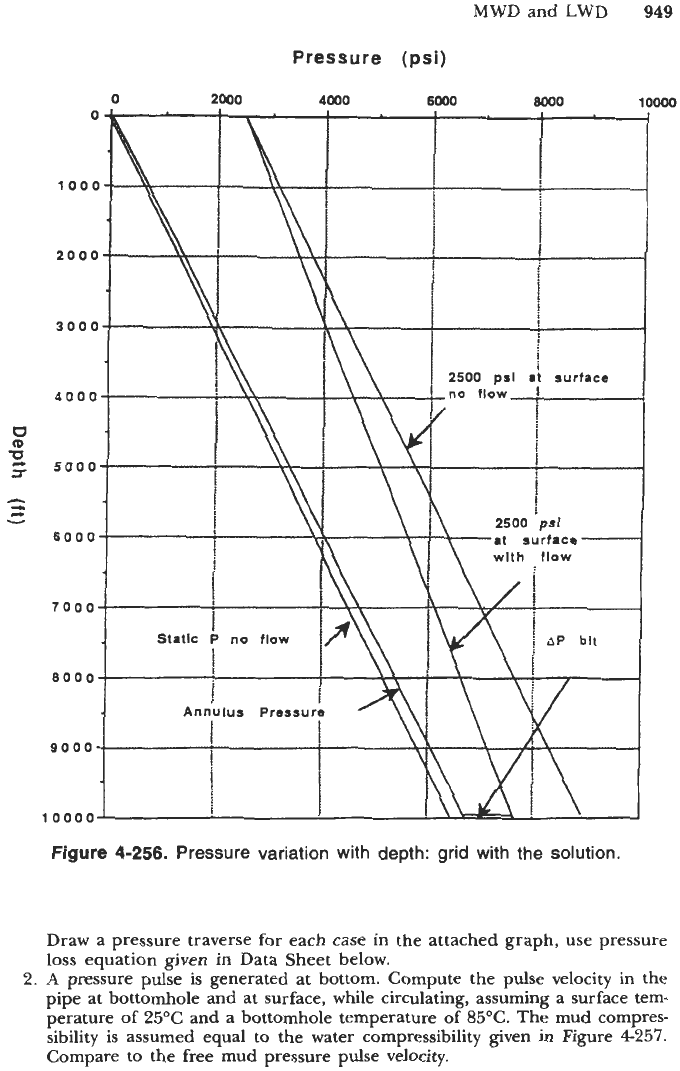
MWD
and
LWD
949
Pressure
(psi)
0 2000
4000
6000
8000
1
OOOO
Figure
4-256.
Pressure variation
with depth: grid with
the
solution.
Draw
a
pressure traverse for each case in the attached graph, use pressure
loss equation given in Data Sheet below.
2.
A
pressure pulse
is
generated at bottom. Compute the pulse velocity in the
pipe at bottomhole and at surface, while circulating, assuming a surface tem-
perature of
25°C
and a bottomhole temperature of
85°C.
The mud compres-
sibility is assumed equal to the water compressibility given in Figure
4257.
Compare to the free mud pressure pulse velocity.
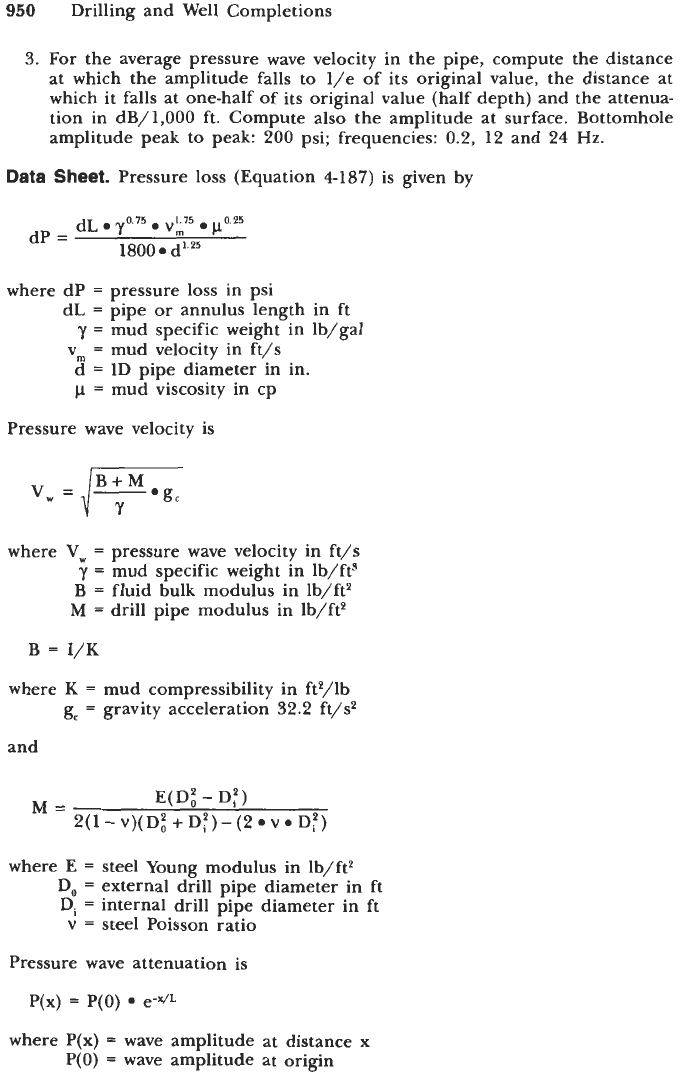
950
Drilling and Well Completions
3.
For
the average pressure wave velocity in the pipe, compute the distance
at which the amplitude falls to l/e of its original value, the distance at
which it falls at one-half of its original value (half depth) and the attenua-
tion in dB/1,000 ft. Compute also the amplitude at surface. Bottomhole
amplitude peak to peak: 200 psi; frequencies: 0.2, 12 and 24
Hz.
Data Sheet.
Pressure loss (Equation 4-187) is given by
where dP
=
pressure loss in psi
dL
=
pipe
or
annulus length in ft
y
=
mud specific weight in lb/gal
vm
=
mud velocity in ft/s
d
=
ID pipe diameter in in.
p
=
mud viscosity in cp
Pressure wave velocity is
where
Vw
=
pressure wave velocity in ft/s
y
=
mud specific weight in lb/fts
B
=
fluid bulk modulus in lb/ft2
M
=
drill pipe modulus in lb/ft2
B
=
1/K
where
K
=
mud compressibility in ft2/lb
g,
=
gravity acceleration 32.2 ft/s2
and
E( Di
-
Df
)
M=
2(1-V)(D;+DP)-(Z*v.Df)
where E
=
steel Young modulus in lb/ft2
Do
=
external drill pipe diameter in ft
Di
=
internal drill pipe diameter in ft
v
=
steel Poisson ratio
Pressure wave attenuation is
P(x)
=
P(0)
e-vL
where P(x)
=
wave amplitude at distance x
P(0)
=
wave amplitude at origin
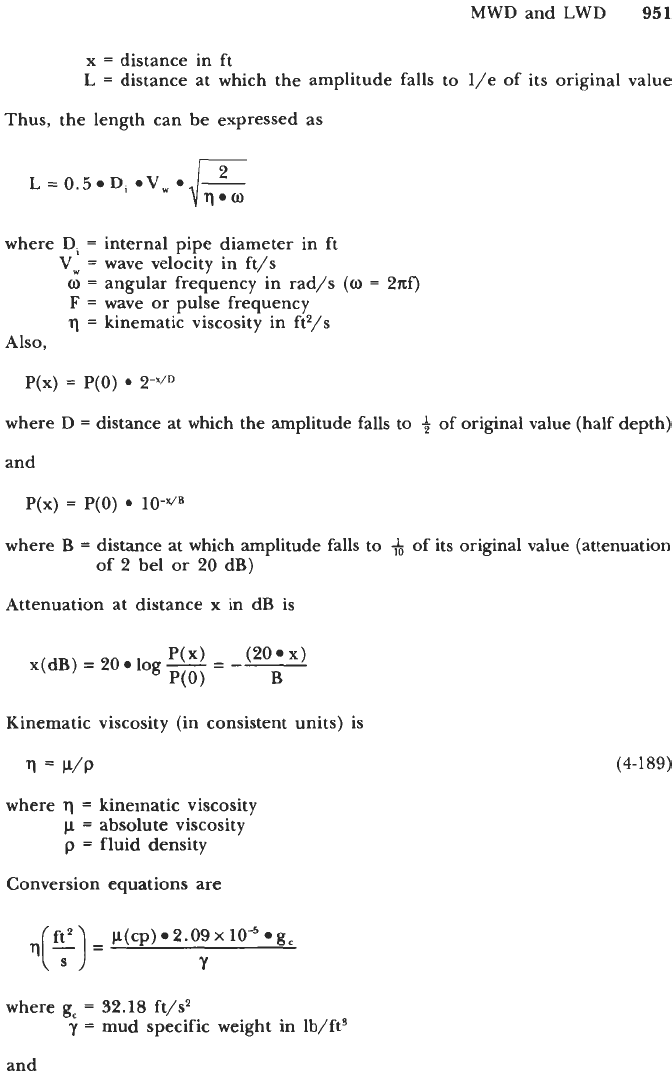
MWD and
LWD
951
x
=
distance in ft
L
=
distance at which the amplitude falls to l/e
of
its original value
Thus, the length can be expressed as
where
Di
=
internal pipe diameter in ft
Vw
=
wave velocity in ft/s
o
=
angular frequency in rad/s
(o
=
2nf)
F
=
wave or pulse frequency
q
=
kinematic viscosity in ft2/s
Also,
P(x)
=
P(0)
2-"D
where
D
=
distance at which the amplitude falls to
+
of original value (half depth)
and
P(x)
=
P(0)
lO-"B
where
B
=
distance at which amplitude falls to
+,
of its original value (attenuation
of
2
bel or
20
dB)
Attenuation at distance
x
in dB is
P(x) (20.x)
x(dB)
=
20.log-
=
--
P(0)
B
Kinematic viscosity (in consistent
11
=
P/P
where
9
=
kinematic viscosity
p
=
fluid density
=
absolute viscosity
Conversion equations are
.(
f$)
=
Mcp)
2.09 x
10"
g,
Y
units) is
(4-189)
where
g,
=
32.18 ft/s2
y
=
mud specific weight in lb/fts
and
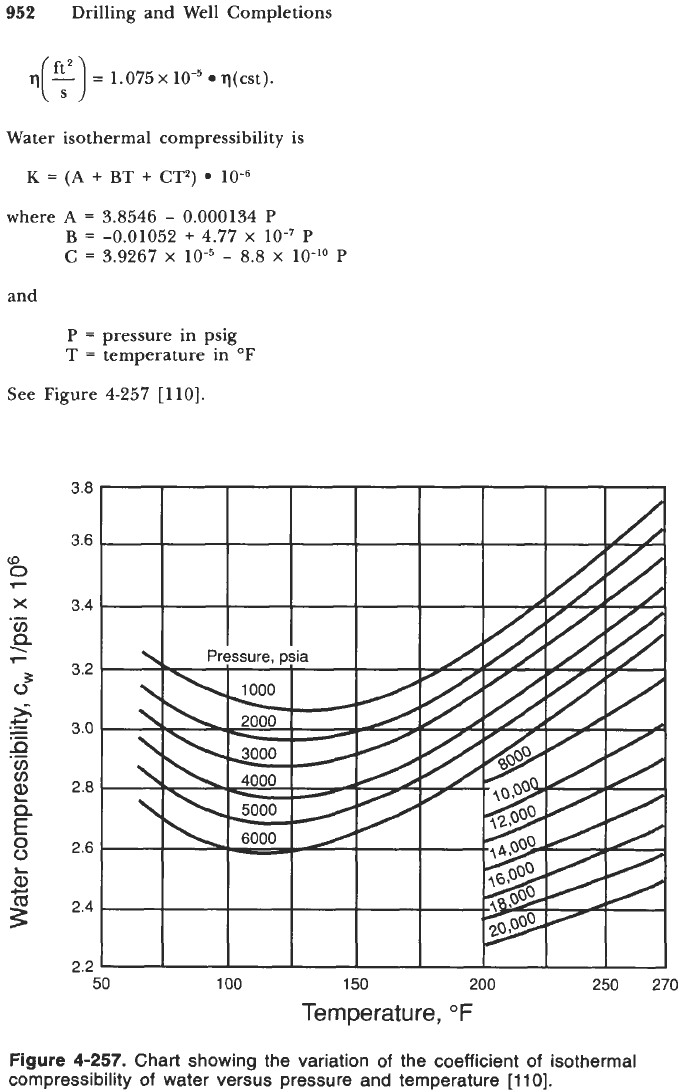
952
Drilling and Well Completions
17
-
=
1.075
x
q(cst).
(4')
Water isothermal compressibility is
K
=
(A +
BT
+
CT2)
where
A
=
3.8546
-
0.000134
P
B
=
-0.01052
+
4.77
x
C
=
3.9267
x
-
8.8
x
P
P
and
P
=
pressure in psig
T
=
temperature in
OF
See Figure 4-257 [110].
3.8
3.6
(D
T
0
x
3.4
2.2
50
100 150
200
250
270
Temperature,
OF
Figure
4-257.
Chart showing the variation
of
the coefficient
of
isothermal
compressibility
of
water versus pressure and temperature
[l
lo].

MWD
and
LWD
953
Solution
1.
a.
6,255
psia
b.
8,740
psia
c,
7,664
psia
2.
Free fluid velocity:
Surface:
4,168.6
ft/s
Bottom:
4,356
ft/s
Velocity in drillpipe:
Surface:
4,044
ft/s
Bottom:
4,215
ft/s
Average velocity in pipe:
4,130
ft/s
3.
Table
4-1
27
Amplitudes at Surface for a
10,000-ft
Well, 200-psi
Downhole Pulses, for Various Frequencies
0.2
Hz
12
Hz
24
Hz
L
83,357
ft
10,761
ft
7,609
ft
D
57,766
ft
7,457
ft
5,273
ft
B
191,971
ft
24,782
ft
17,523
ft
Attenuation 0.104 dBll,000
ft
0.807
dB11,OOO
ft
1.141 dB/1,000
ft
Pulse p-p amplitude at surface
177.4 psi
78.96 psi 53.73 DSi
Example
11
:
Mud Pulse Telemetry-Fluidic Pulser Calculations
We have built a fluidic pulser system that can generate approximately
100
psi
peak to peak with
500
gal/min mud flowrate. It is to be used down to
15,000
ft.
The surface detector needs a 5-psi peak to peak sine wave for proper phase
detection. The following oil-base mud is used:
density:
12
lb/gal
viscosity:
25
cp
pressure wave velocity in the drill pipe:
3685
ft/s
drillpipe diameter:
4.5
in.
OD,
3.64
in.
ID.
The system transmits
5
bits/s with a phase-shift-keying system. Four sine waves
are necessary to define the phase with a negligible chance of error. Assume a
perfect pipe, drill collar
ID
same as the drill pipe and no wave reflections at
the drill pipe ends.
1.
What frequency(s) should be used?
2.
What peak-to-peak amplitude (psi)
of
the pressure wave
is
necessary at
bottom to get the required peak to peak value at surface?
Is
our pulsing
device suited for this job?
3.
The pump noise frequency is varying around
8 Hz
with a peak-to-peak
amplitude of
20
psi. Can the signal still be detected? Explain.
4.
If
we generate a
12-Hz
wave at surface to transmit instructions downhole
to the instrument package, what amplitude should it have at surface to
reach bottom with
5
psi peak to peak?
5.
Can both channels work simultaneously with proper filtering? Explain.
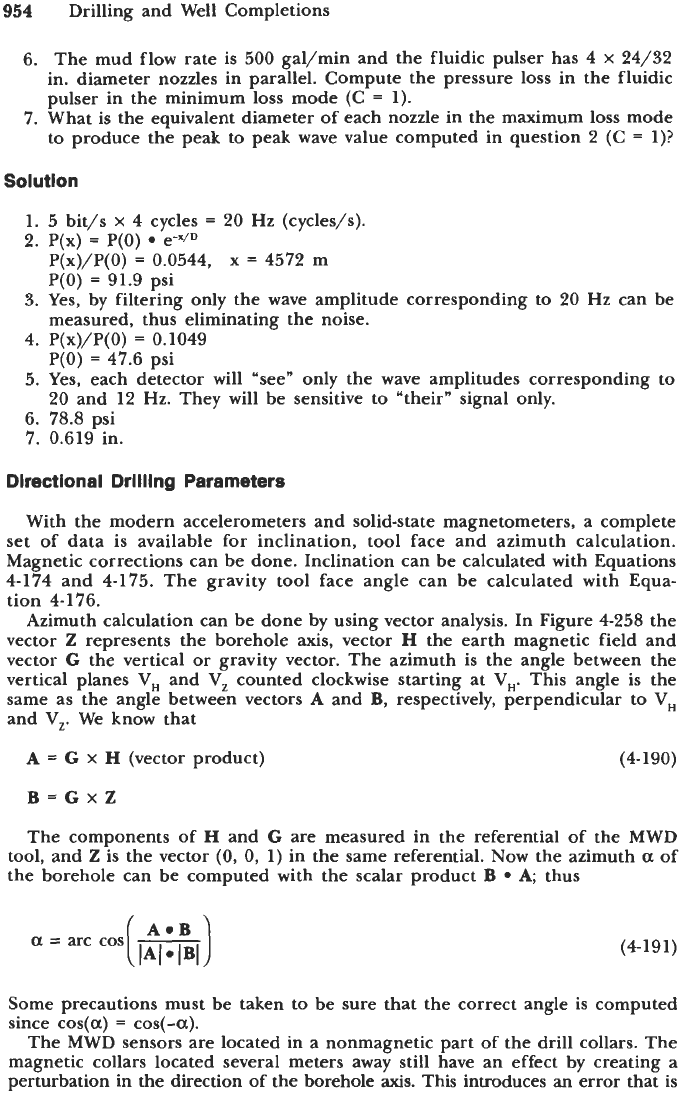
954
Drilling and Well Completions
6.
The mud flow rate is
500
gal/min and the fluidic pulser has
4
x
24/32
in. diameter nozzles in parallel. Compute the pressure loss in the fluidic
pulser in the minimum loss mode (C
=
1).
7.
What is the equivalent diameter of each nozzle in the maximum loss mode
to
produce the peak to peak wave value computed in question
2
(C
=
l)?
Solution
1.
5
bit/s
x
4
cycles
=
20
Hz (cycles/s).
2. P(x)
=
P(0)
e-JD
P(x)/P(O)
=
0.0544,
x
=
4572
m
P(0)
=
91.9
psi
3.
Yes, by filtering only the wave amplitude corresponding to
20
Hz can be
measured, thus eliminating the noise.
4. P(x)/P(O)
=
0.1049
P(0)
=
47.6
psi
5.
Yes, each detector will "see" only the wave amplitudes corresponding to
20
and
12
Hz. They will be sensitive to "their" signal only.
6. 78.8
psi
7. 0.619
in.
Dlrectional Drilling Parameters
With the modern accelerometers and solid-state magnetometers, a complete
set of data is available for inclination, tool face and azimuth calculation.
Magnetic corrections can be done. Inclination can be calculated with Equations
4-174
and
4-175.
The gravity tool face angle can be calculated with Equa-
tion
4-176.
Azimuth calculation can be done by using vector analysis. In Figure
4-258
the
vector
2
represents the borehole axis, vector
H
the earth magnetic field and
vector
G
the vertical or gravity vector. The azimuth is the angle between the
vertical planes
V,
and
V,
counted clockwise starting at
V,.
This angle is the
same as the angle between vectors
A
and
B,
respectively, perpendicular to
V,
and
V,.
We know that
A
=
G
x
H
(vector product)
(4-1 90)
B=GxZ
The components
of
H
and
G
are measured in the referential
of
the MWD
tool, and
Z
is
the vector
(0,
0,
1)
in the same referential. Now the azimuth
a
of
the borehole can be computed with the scalar product
B
A
thus
(4- 19 1)
Some precautions must be taken to be sure that the correct angle is computed
since cos(a)
=
cos(-a).
The MWD sensors are located in a nonmagnetic part of the drill collars. The
magnetic collars located several meters away still have an effect by creating a
perturbation in the direction of the borehole
axis.
This introduces
an
error that is
